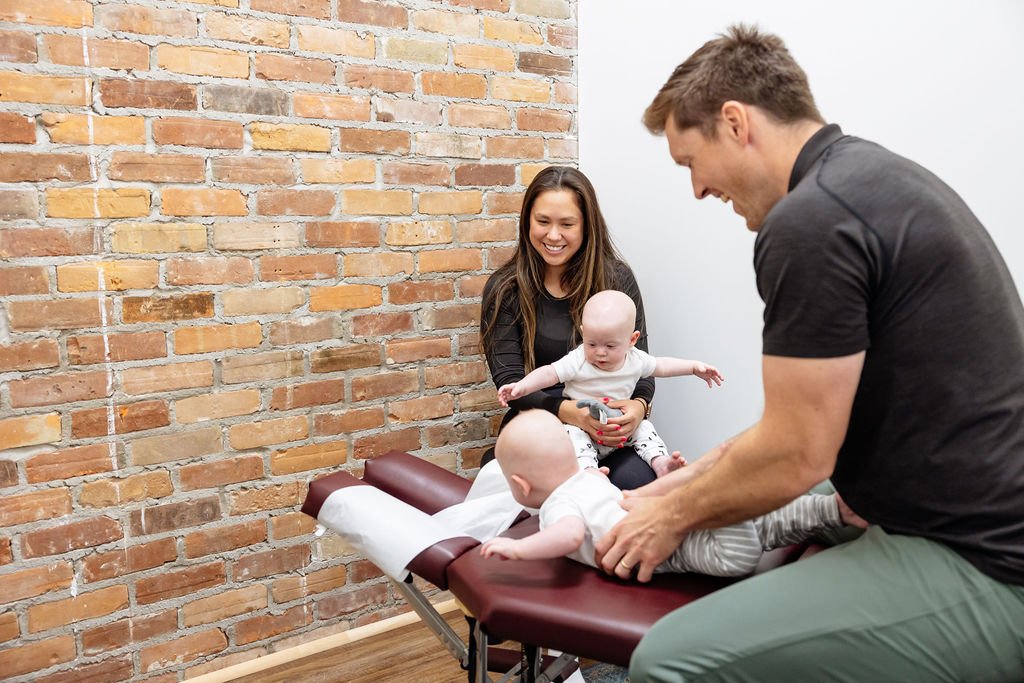
Infant Chiropractic Care
The birthing process can be traumatic, which can have negative effects on both mama and baby.
Dr. David Blair treats babies as little as a few weeks old to toddlers for a number of various issues:
Breastfeeding difficulties
Acid reflux
Sleep disturbances
Colic
Constipation
Lip & tongue tie
Tummy time
Torticollis
High or low muscle tension or tone
The treatment involved is very gentle - about same amount of pressure that would be applied to check a tomato for ripeness.
Get Your Free Infant Chiropractic E-Guide
Read all about Infant Chiropractic services and WATCH a live Infant Chiropractic Assessment in this PDF
Help facilitate proper feeding, movement and reach milestones with your baby with the support of an Infant Chiropractor like Dr. David Blair.
What should I expect with infant chiropractic care?
Every session involves constantly assessing and screening your baby’s movement patterns and joint dynamics.
Dr. Blair employs a whole body approach and looks at functional movement, muscle tone, spinal and pelvis alignment each visit.
Dr. Blair involves caregivers and teaches them exercises and interventions to use at home between visits.
Your baby’s diagnosis and wellness will be thoroughly explained to you - we want you to be an active member in your baby’s wellness and growth!
Frequently Asked Questions
-
When spinal, limb and cranial joints do not move correctly, they are not able to adequately communicate with the nervous system. The nervous system is what controls the body, running through it and managing all its functions, both consciously and subconsciously.
The nervous system relies on receiving accurate information from the joints (a phenomenon called proprioception) and muscles to function and develop optimally. Problems that are commonly associated with these joint dysfunctions include poor sleep quality, growing pains, constipation, posture problems, and behavioral issues. Chiropractic care treats more than just pain! Chiropractic care restores proper joint function and communication which will help your child’s body move, heal, and develop.
-
If there are any physical health problems your child is facing, an infant chiropractor can determine whether or not treatment is appropriate for them. If the identified problem is related to, or made worse, by an improperly moving joint or poor communication between the body and the brain, then an infant chiropractor can help. In most cases with babies, there no pain complaint regarding joint dysfunction (though not always). Babies should be monitored for clues of biomechanical unease.
With the impact that spinal adjustments have on sensorimotor integration and autonomic function, symptoms that babies may have that are unrelated to pain can be treated with chiropractic care. Gastrointestinal, behavioral, developmental, and immune conditions and problems can all be treated without the aid of medication. Chiropractic care is also preventative care and can address problems before they progress into something worse.
-
Every single Doctor of Chiropractic (DC) receives paediatric training as part of their core curriculum during chiropractic college. Dr. David Blair continued his studies post-doctorate with the International Chiropractic Paediatric Association (ICPA) to hone his skills in working with this special population.
-
Chiropractic care for infants is gentle and safe. If it were unsafe, then it would not be part of the core curriculum for those training to become chiropractic doctors. Chiropractors are extremely well-trained health professionals and treating children is a part of the services that they offer. During a chiropractic doctorate, prospective chiropractors study anatomy, orthopaedics, physiology, neurology, and nutrition, all of which include the unique needs that children have regarding chiropractic practice. The chiropractic techniques used for children have some differences than the ones used for adults and are incredibly gentle, safe, and beneficial.







